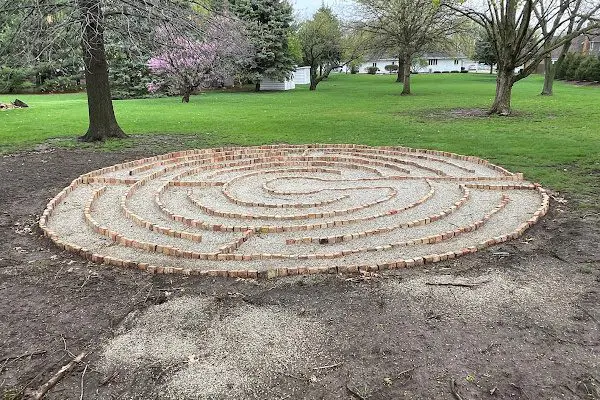WHAT IS THE LABYRINTH?
The labyrinth is a simple walking path used to meditate or quiet the mind. It is a path
of reflection, contemplation and clarity. Labyrinths come in many sizes and patterns,
but a labyrinth has only one path. The path winds through and becomes a mirror for
where we are in our lives. The labyrinth is a wonderful tool for re–connecting the
mind, body, and spirit. For some, it allows self–realization that provides peace,
healing, and comfort.
The labyrinth is an ancient pattern found in many cultures around the world.
Labyrinth designs were found on pottery, tablets, and tiles dating as far back as
4,000 years. Many patterns are based on spirals from nature. In Native American
culture it is called the Medicine Wheel and Man in the Maze. The Celts described it as
the Never-Ending Circle. It is also called the Kabala in mystical Judaism. One feature
they all share is that they have one path that winds in a circuitous way to the center.
Early in Church history going on “the Way” or, later, on a “pilgrimage” to places such
as Guadalupe, Częstochowa and Compostella were seen as a prayer discipline.
Processionals as prayer arose from the same understanding. During the Middle Ages
when the Crusades closed the route of Christian pilgrims to the Holy Land, two forms
of walking meditation surfaced: the “Stations of the Cross” and the labyrinth. The
best-known labyrinth in this tradition is the one on the floor of Chartres Cathedral in
France which is the one our Labyrinth (outside next to the Stations of the Cross) is
based upon.
Labyrinths are currently being used worldwide to quiet the mind, find balance, and
encourage meditation, insight and celebration. They are open to all people as a
non–denominational, cross-cultural tool of well–being. They can be found in medical
centers, parks, churches, schools, prisons, memorial parks, and retreat centers and in
people’s backyards.
The labyrinth is not a maze. There are no tricks to it and no dead ends. It has a single
circuitous path that winds into the center. The person walking it uses the same path
to return and the entrance then becomes the exit. The path is in full view, which
allows a person to be quiet and focus internally.
Generally, there are three stages to the walk:
- Releasing on the way in.
- Receiving in the center.
- Returning; that is, taking back out into the world that which you have received.
There is no right way or wrong way to walk a labyrinth. Use the labyrinth in any way
that meets what you need.
WHAT DOES LABYRINTH WALKING INVOLVE?
One walks a labyrinth into the center and then out of the center on the same path. Walk the labyrinth
with an open mind and an open heart. Take a moment before entering to pause and clear your mind.
Become aware of your breath. Enter the labyrinth allowing your body to set its own pace. You may
“pass” people or let others step around you whichever is easiest at the turns. The path is two ways.
Those going in will meet those coming out. Do what feels natural.
There are three phases to the labyrinth walk:
- Entering: Release and let go of the details of your life. This is an act of shedding thoughts and emotions. It quiets and empties the mind.
- Illumination: (Also called “communion”) This is when you have reached the center. This is a place of meditation. Pause and receive what is there for you.
- Exiting / re-integration: Walk out the same path you entered. Integrate and connect your thoughts.
TIPS FOR THE LABYRINTH WALK
- If others are using the labyrinth, please refrain from talking.
- It takes about 20-30 minutes to walk the path.
- Walk at your own pace.
- If multiple people are using the labyrinth, please wait until the person in front of
you has rounded the third turn (near the center) before you begin walking the
path. - You may pass another person. The best place to pass is at a corner turn. If you
meet someone coming the opposite direction, making eye contact with the other
person is a good way to give/obtain permission to pass.
WHAT HAS BEEN PROVEN?
The labyrinth often brings a participant relaxation and peace. It can provide insights
and improve one’s ability to cope with stress. Some anecdotal evidence suggests
that it may lower blood pressure


